Ubuntu operation tutorial
3.1 Open terminal under Ubuntu##
The Ubuntu we installed is the desktop version, so that we can operate like under the windows system. Compared with the usual Linux command line operation, this experience is very comfortable. But generally we use Linux to operate under the command line. All operations can be done by entering commands. In most cases, using the command line to operate the Linux system is much more efficient than operating under the GUI. Although the Ubuntu we are using is a Linux distribution that includes a GUI, we can call up the Ubuntu terminal like under windows. It is very simple to open the Ubuntu terminal. Taking Ubuntu 18.04 as an example, there is a way It can be directly under the Ubuntu user interface.
3.1.1 Open terminal with search box###
We have to enter various commands, we need to open the terminal first.
Click the icon in the upper left corner of the Ubuntu desktop to enter the search box, and enter "term" to pop up the terminal "Terminal"
Program, run it, as shown below:
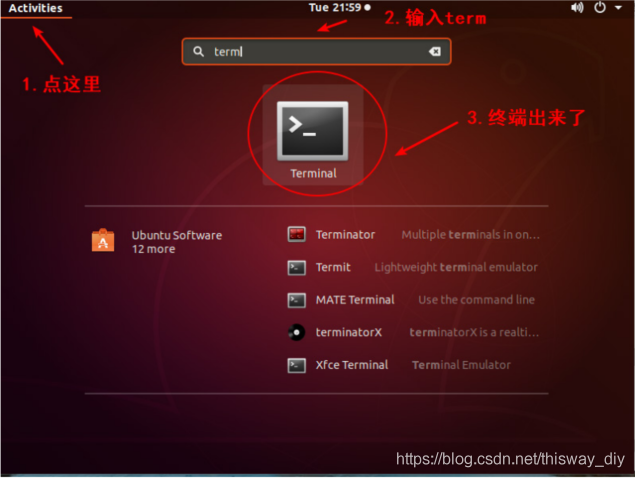
Then you can execute various commands in it.
3.1.2 Use the right button to open the terminal###
- The first is the more conventional method: right-click on the desktop or any directory in the file browser and select "Open in Terminal" in the pop-up menu bar
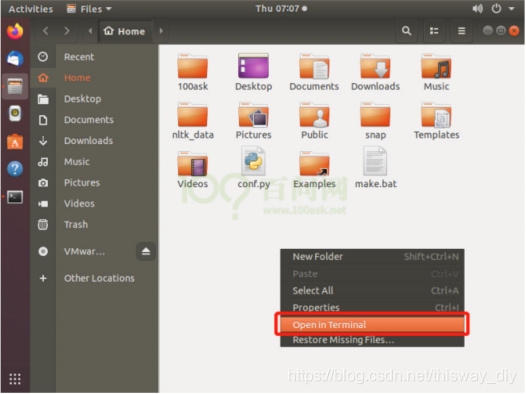
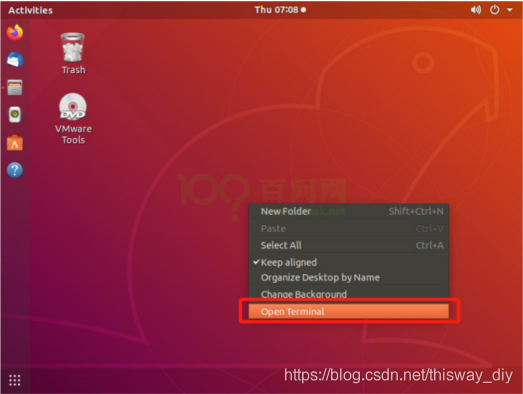
3.1.3 Shortcut key to open terminal###
This is a quicker and more convenient method: use the shortcut to open the terminal, the shortcut is "Ctrl+Alt+T", using the shortcut can directly call up the Ubuntu terminal in most cases (whether you are in the browser or file management You can call up the Ubuntu terminal directly, such as checking emails, working in an opened terminal, etc.)
3.1.4 Adjust the font size and color of the terminal###
There are terminals available now, but what should we do if we want to adjust the font size of the terminal? There are also two ways to adjust the font size of the terminal:
The first is to introduce a more conventional method. Under the opened terminal, right-click on the terminal interface and select "Preferences"
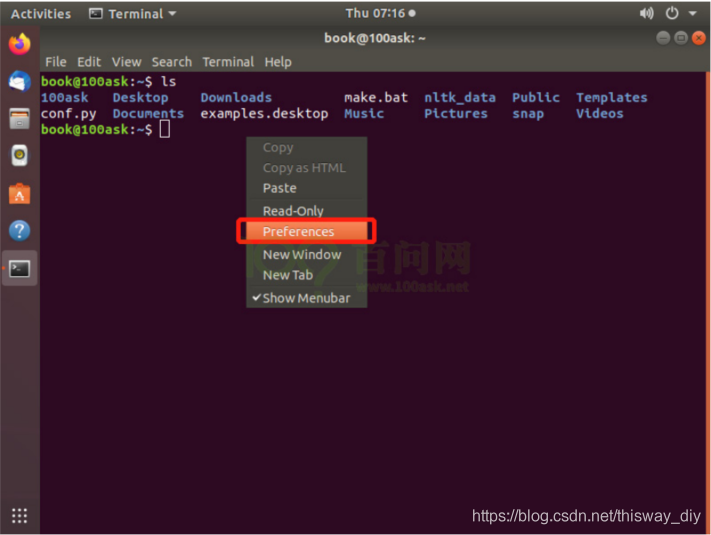
Click to select "Preferences" and you will enter, the following configuration interface, check "Custom font":
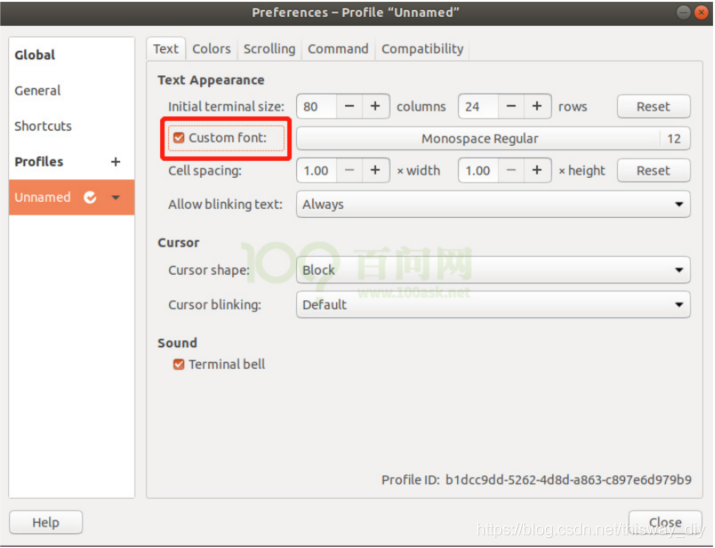
After checking "Custom font", the "Monospace Bold" button on the right will be activated, and we will click the "Monospace Bold" button on the right to enter the next configuration interface:
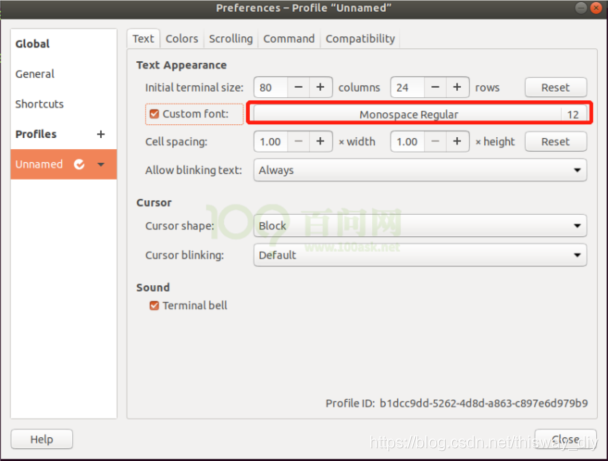
After coming to the following interface, we can adjust the font size and even the font style of the terminal. Here, please choose according to actual needs:
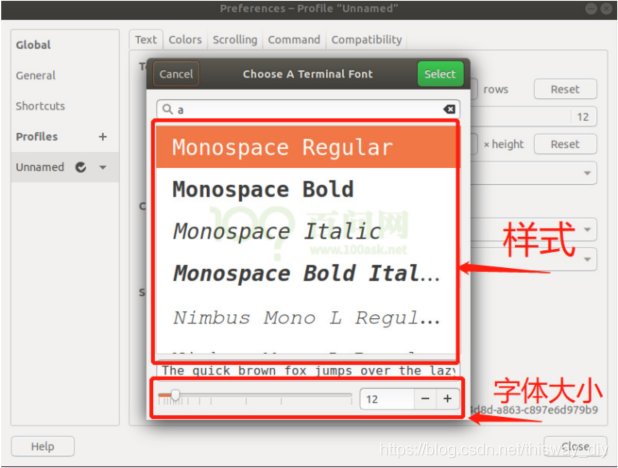
- If we just want to adjust the font size of the terminal, there is a very convenient and quick shortcut:
- Increase the font size: Ctrl + Shift +'+' (the last is the symbol +)
- Reduce the font size: Ctrl +'-' (the last is the symbol -)
3.2 Ubuntu system first experience##
3.2.1 The biggest difference between Ubuntu and Windows: Directory
Each partition in Windows corresponds to a drive letter, and directories and files can be stored under the drive letter:

Note: A directory is a folder.
The absolute path of a file under Windows starts with the drive letter, for example: C:\abc\def\hello.txt, which is in the abc directory of the C drive, and has a def subdirectory; and def contains the hello.txt file.
In Ubuntu, folders and files are represented in a tree structure without the concept of a drive letter. For example: /abc/def/hello.txt, which means that there is a subdirectory of abc in the root directory, and a directory of def under abc; there is a hello.txt file in def.
From the name "/abc/def/hello.txt" you cannot know which partition the hello.txt file is located in.
Note: To check which directory a partition is mounted in, you can execute the command: df -h
For ordinary users, they no longer care about partitions and drive letters under Ubuntu. What you need to care about is which directory contains what:

The directories in Ubuntu follow the FHS standard (Filesystem Hierarchy Standard). It defines the principles of catalog and file classification in the file system, defines the minimum files and catalog collections required for the operation of the system, and lists the exceptions and their reasons for not following these principles. FHS is not a mandatory standard, but most Linux and Unix distributions follow FHS.
These directories are briefly described as follows:
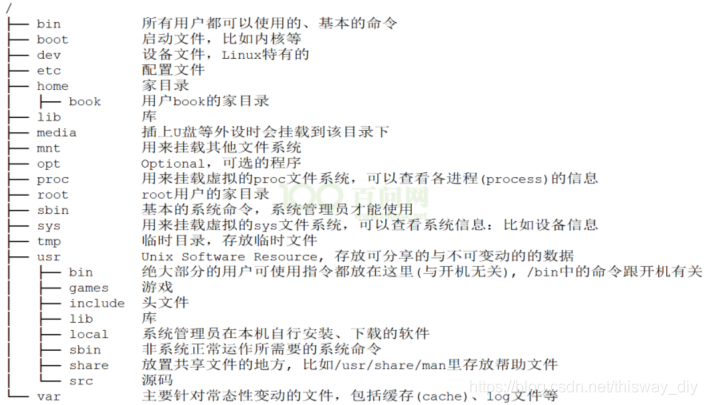
3.2.2 Linux file attributes###
Execute the "ls -al" command in the terminal to display the detailed information of all files and folders in the current directory.
The file attribute diagram is as follows.
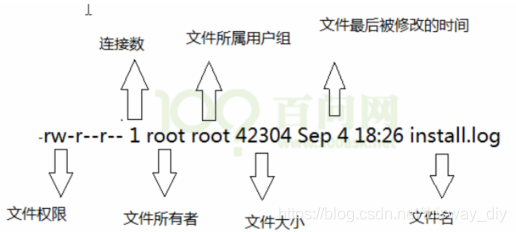
The first character means "file type", which is a directory, file, or linked file, etc.

The 9 characters after the file type are grouped into three groups. The first group represents "the permissions of the file owner"; the second group represents the "user group permissions"; the third group represents "the permissions of other non-user groups" . Each group is a combination of rwx, where r stands for readable, w stands for writable, and x stands for executable; if there is no corresponding permission, a minus sign (-) will appear. For example, "rw-r–r--" means: the owner of the file has read and write permissions for the file, but no execution permission; other users in the same user group only have read permissions for the file; other users have the file Only read permission.
- Number of connections: Indicates how many file names are connected to this node.
- File owner: indicates the "owner's account" of this file.
- The user group to which the file belongs.
- File size: indicates the size of the file, the default unit is B (bytes). The last modified time of the file: the file creation date or the most recent modification date of this file.
- File name: the file name of the corresponding file. If there is a "." before the file name, it means that the file is a "hidden file", and the hidden files can be listed by executing the "ls -a" command.
3.2.3 Settings screen###
In our follow-up learning process, the Ubuntu desktop system is rarely used, and they are all remotely logged in. But if Ubunut's desktop display is too small or too large, it will always make people uncomfortable. At this time, you can modify the screen resolution as follows:
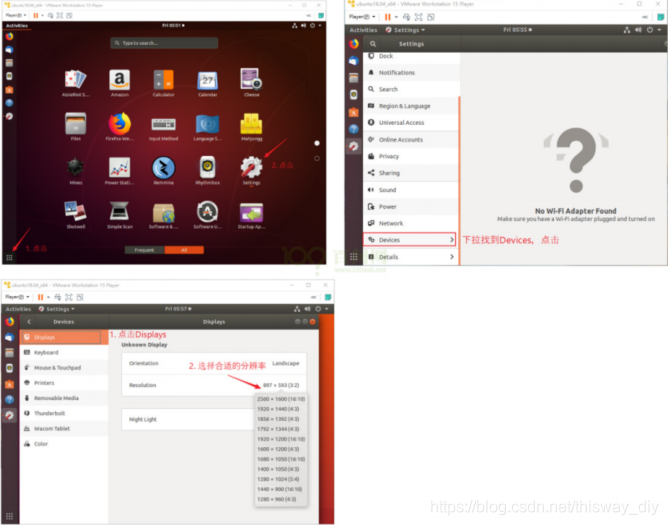
3.2.4 System shutdown and restart###
Just like when we use the Windows system, when we do not use the Ubuntu system, we need to shut it down or sleep. Do not shut down by exiting the VMware software directly! ! The general steps are:
Shut down the system in the virtual machine system or suspend the virtual machine on the VMware software -> close VMware software -> close the windows system
Shutting down and restarting Ubuntu is very simple. On the main interface, click the icon in the upper right corner, and then select the corresponding option, as shown in the following figure:
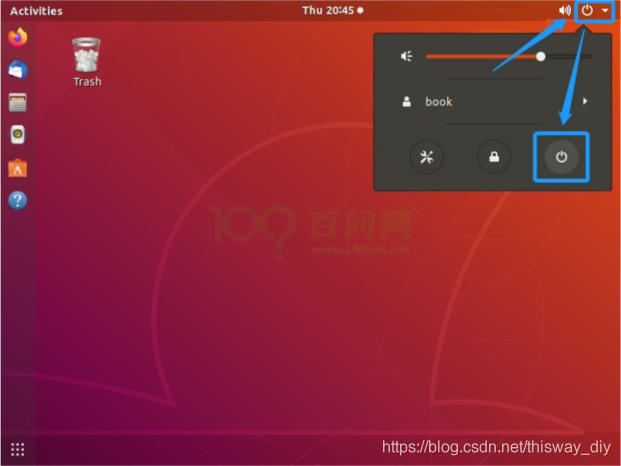
In the pop-up dialog box, we can perform restart or shutdown operations. Click the cancel button to exit this dialog box, as shown in the following figure:

At this point, careful readers may find that there is another option for us under windows system is "sleep", there is no sleep option in Ubuntu. In fact, we can implement the sleep operation of the virtual machine system through VMware software, that is, the suspend operation. After the virtual machine system is suspended, we can directly restore the virtual machine to the state when it was suspended next time. Suspending a virtual machine is very simple. The power operation icon on the VMware navigation bar or the power option of the menu called by right-clicking on the virtual machine tab also has a suspend operation, as shown below:
Suspend on the power operation icon on the VMware navigation bar:
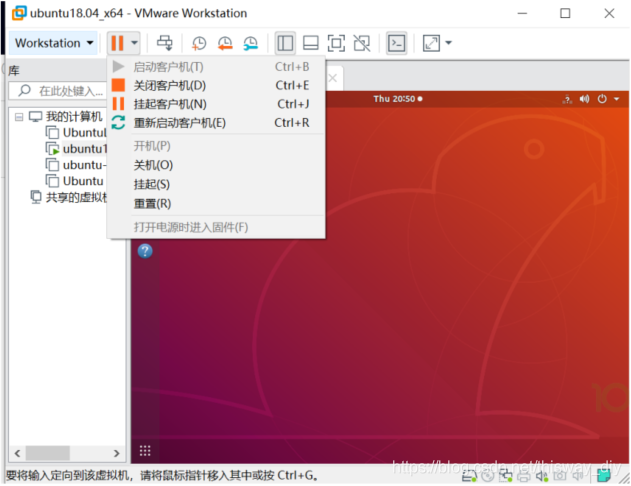
Suspend in the power option of the menu called by right-clicking on the tab of the virtual machine:
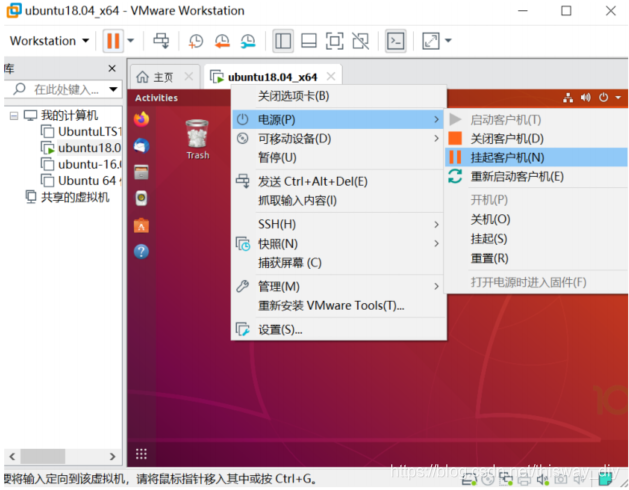
3.2.5 File Browser###
Every system with a GUI should have a file browser. The desktop version of Ubuntu we use is no exception. So how do you open the file browser of Ubuntu?
In fact, it is very simple to open Ubuntu's file browser. The file browser can be opened directly in the default left navigation bar of Ubuntu, as shown in the following figure:
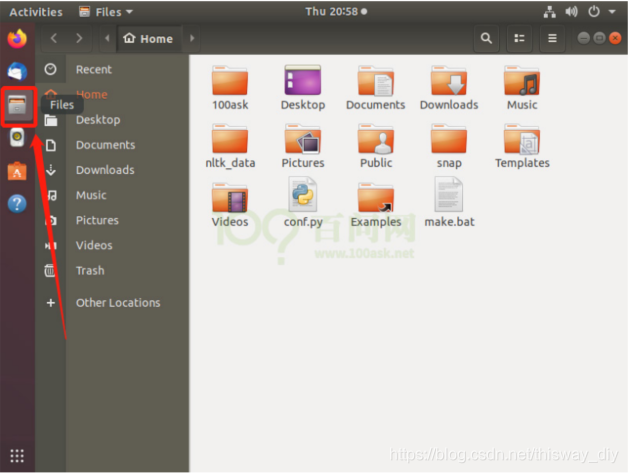
Or we can find the file browser to open in all applications, as shown below:
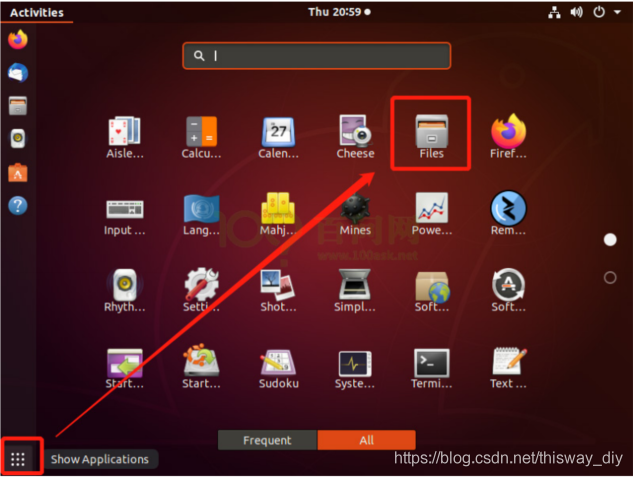
After opening the file browser, we can browse all the files in the disk like using file explorer under windows system.
Recommended Posts